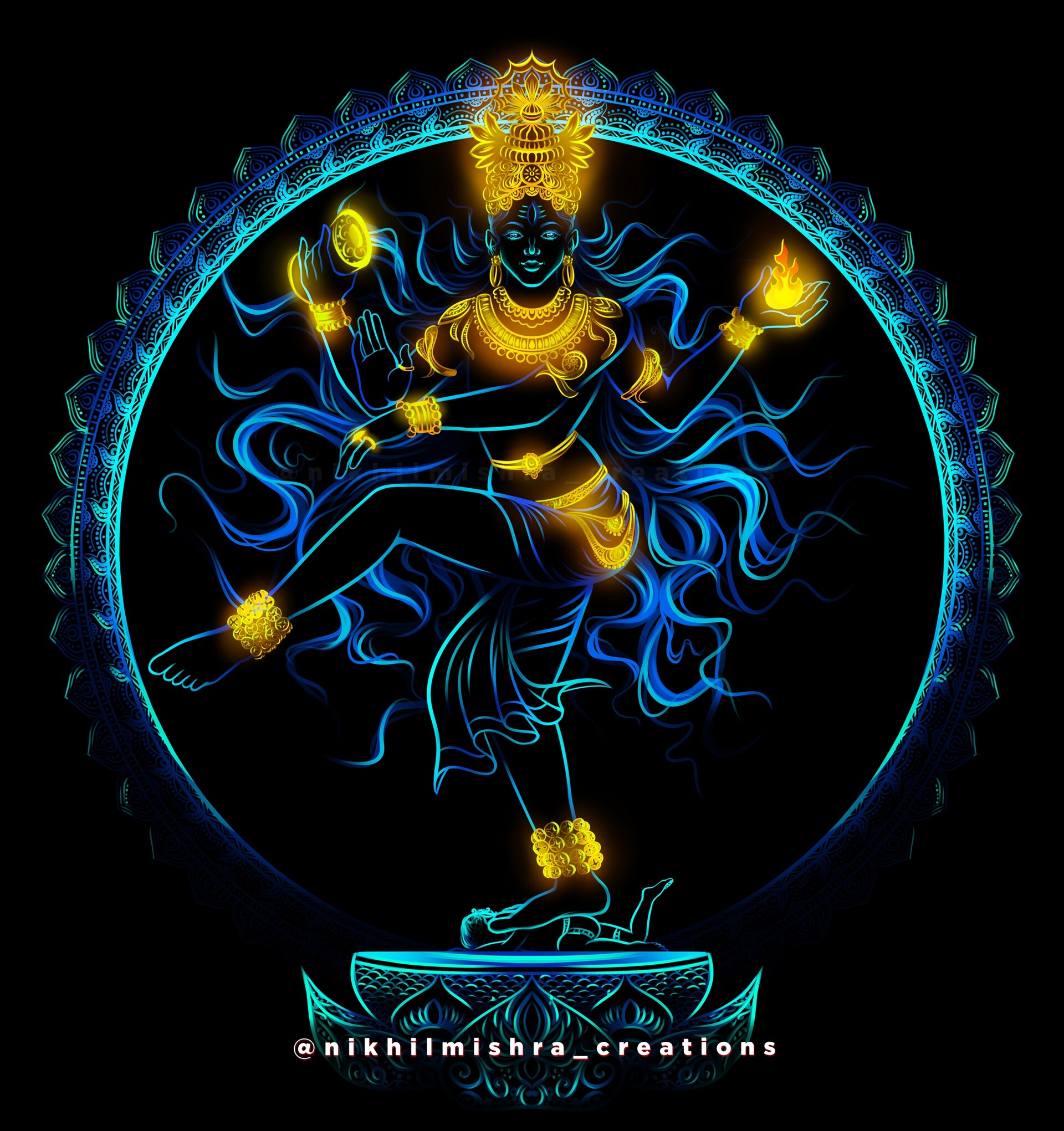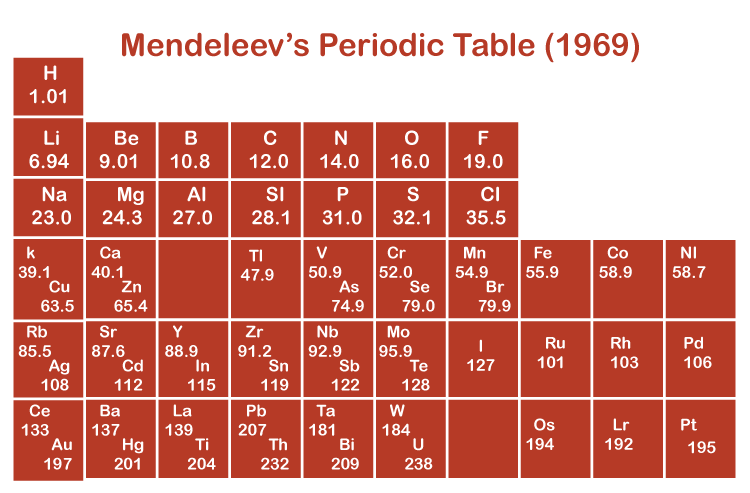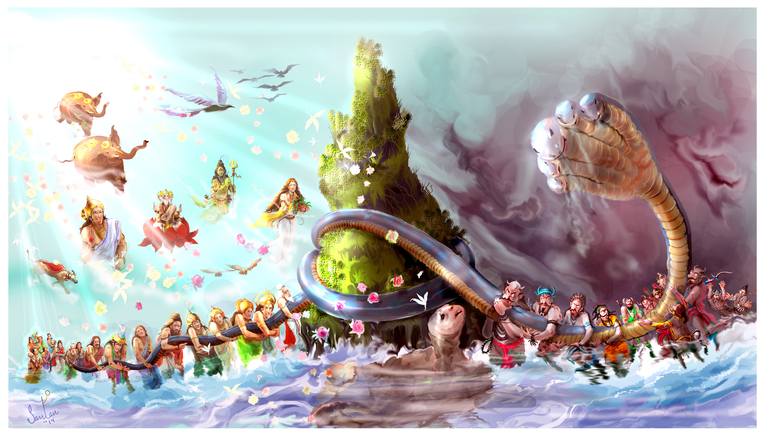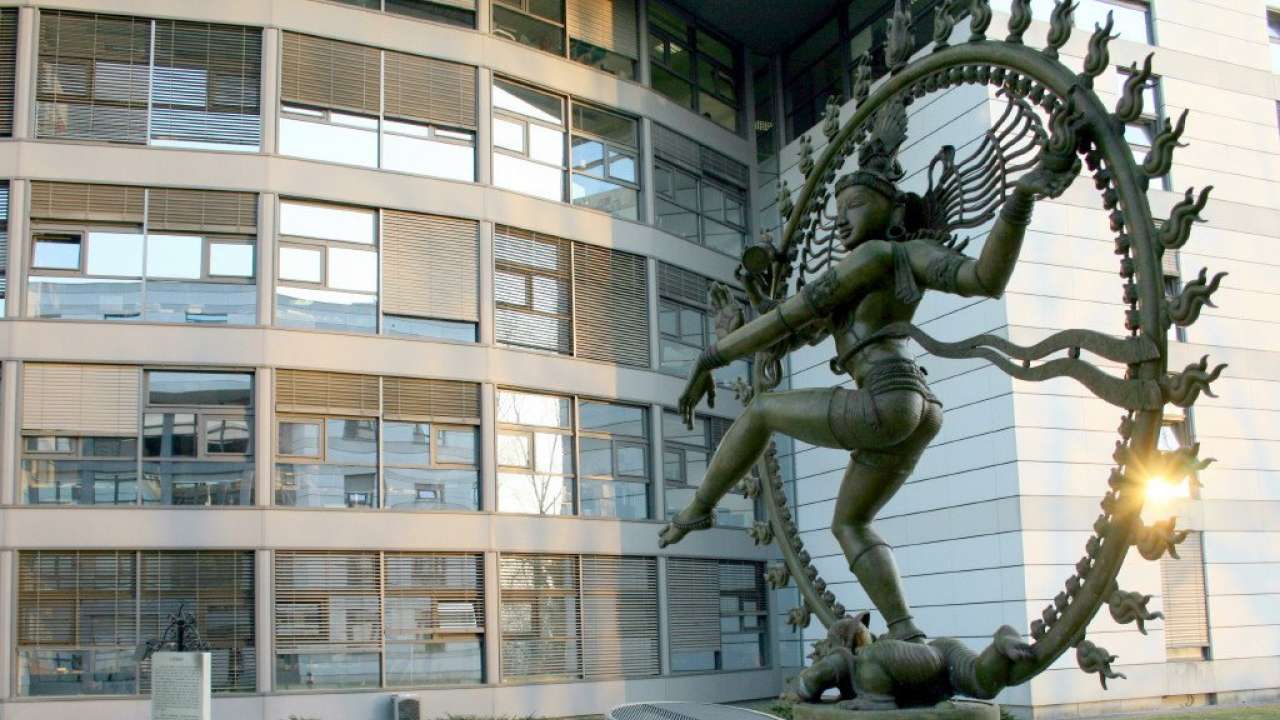S
Shruti Dasgupta
Guest
The Nataraja Statue represents Lord Shiva’s Tandava or Cosmic Dance with 108 mudras or dance poses. However, there is more to the Divine roop of Kaal Bhairava than what meets the eye at first glance. The sculpture is a Sanatana Dharma symbol layered in symbolism that extends beyond the realm of dance in the arena of science. What is the connection between the Nataraja Mudras, the Samudra Manthan, and the 108 stable elements in the periodic table? What is the truth about Medeleev’s Periodic table? Why is there a Murti of Nataraja at CERN in Switzerland?

PC ArtStation
Sanatana Dharma also worships Lord Shiva in his Nataraja roop. He is known as the ‘Lord of the Dance’ in both literal and allegorical ways. The legend of Lord Nataraja is one of pathos and grief where Lord Shiva unleashes his power of destruction through the Tandava on the death of his wife Sati. The Tandava is mostly referred to as the ‘Dance of Destruction’. However, this is an oversimplified explanation of the term. The Shiva Tandava embodies the eternal cycle of creation and destruction in the universe. Thus, the 108 Mudras or Dance Poses are the results of the struggle between feminine Shakti and masculine consciousness.
The 108 poses of Nataraja showcase the 108 manifestations of energy in the cosmos as a result of the interaction between the two divine forces. Thus, if one carefully observes, Nataraja stands on a small rakshas-like figure. This figure represents the Cycle of Time or Kaal. Suppression of Kaal by Nataraja denotes the absence of time during the Cosmic Dance that can cause both destruction and creation in the universe. Among the Divine Trinity of Brahma, Vishnu, and Mahesh; Lord Shiva is the only one that can control time or Kaal. This is partly the reason he is also called ‘Kaal Bhairav’, referring to the fear form of Lord Shiva of which Kaal or Time is even scared.

PC Javatpoint
The Mendeleev periodic table was created by Russian chemist Dmitri Mendeleev. It is a fundamental tool in the study of chemistry. The table organizes the elements based on their atomic number and chemical properties. Each element is assigned a unique position on the table. However, when Mendeleev first printed his periodic table there were only 63 known or discovered elements. However, he had made the table for 108 stable elements. He had even predicted the properties of some undiscovered elements.
:max_bytes(150000):strip_icc()/ThoughtCo_List_Of_Radioactive_Elements_608644_V12-e91d220318ed4143a7ff5a9407af6555.png)
PC ThoughtCo.
Although modern science claims that there are only 118 stable elements, there are 94 known natural elements. The others are isotopes of the existing elements. There are a few more unstable elements in larger periodic tables.
Probably. Can the true number of naturally stable elements be 108? Most likely. Is there a relationship between the Periodic Table and Nataraja’s Mudras? The answer may be ‘Yes’, but only for those who understand that science is a search for answers. Those who choose ‘Yes’ to that answer will also realize that most scientific things are explained via allegory in Sanatana Dharma.
Maybe the 108 Unique Dance Poses of Nataraja correspond to 108 stable natural elements. Possibly the Tandava is also a symbolic representation of the manifestation of matter. Most likely the Cosmic Dance represents the way energy transforms naturally on Earth.

PC Saatchi Art
A simplified form of the legend of Samudra Manthan is that it was a churning of the cosmic ocean to obtain the nectar of immortality. Moreover, sometimes it is used to represent the eternal struggle between divine and demonic forces. However, please note that there were 54 Asura and 54 Deva that churned the cosmos using Vasuki.
Vasuki is the snake around Lord Shiva’s neck. He also represents Kaal or the eternal cycle of life. Thus, 108 people churned the cosmic ocean using Vasuki to form the celestial bodies, earth, flora, fauna, metals, and riches. It also gave Lord Vishnu his wife Ma Lakshmi, his mace and bow as ‘astra’ for being the preserver of all life in the Cosmos. Therefore, it can be stated that 108 elements merged in different combinations in time to form all things on Earth and the cosmos. So, is Nataraja a way for Sanatana Dharma to remember the origins of creation? Is Tandava the true origin story of the Cosmos?

PC DNA India
By now the world partly acknowledges the brilliance of Vedas and concepts of Sanatana Dharma. The ‘White Men’ usually plagiarized Sanatana concepts under the guise of translating Sanatana texts for further study. However, most scientists have acclaimed that the Bhagavad Gita and the Vedas changed their lives and helped their modern scientific discoveries. This was their way of asking forgiveness from the civilization from whom they took away credit. Credible scientists like Albert Einstein, Neil Bohr, Erwin Schrodinger, Nikola Tesla, Max Planck, and many others publicly announced themselves as students of the Vedas.
Thus, the presence of a Nataraja statue at CERN is not surprising. This European Organization for Nuclear Research is a center dedicated to exploring the fundamental forces of the universe. And who is better than Nataraja to guide them on this path to understanding the cosmos? Therefore, these atheists, Jews, or Christian Scientists subtly acknowledge the divine Nataraja and his Cosmic Dance by placing him in a laboratory where subatomic particles are studied. They probably seek his blessings to unravel the mysteries of existence.
Nataraja’s cosmic dance transcends the boundaries of art and leaps into science and philosophy. Understanding the connection between the 108 Mudras or Dance Poses, the Periodic Table, and the Samudra Manthan helps Sanatanis uncover the beauty of their Dharma. The pursuit of knowledge and the understanding of the universe’s intricacies are incomplete without understanding the allegorical meaning behind Lord Shiva Nataraja’s roop.
Nataraja is a timeless reminder of the harmonious interplay of creation and destruction. It helps the world to understand the interconnection between science and Sanatana Dharma. Moreover, it helps Sanatanis to delve deeper into the Vedic texts to understand hidden gems of wisdom that may have missed their notice due to oversimplification.
The post What is the Science Behind the Nataraja Statue? – A Sanatana Perspective appeared first on The Jaipur Dialogues.
Continue reading...
The Symbolism of Nataraja

PC ArtStation
Sanatana Dharma also worships Lord Shiva in his Nataraja roop. He is known as the ‘Lord of the Dance’ in both literal and allegorical ways. The legend of Lord Nataraja is one of pathos and grief where Lord Shiva unleashes his power of destruction through the Tandava on the death of his wife Sati. The Tandava is mostly referred to as the ‘Dance of Destruction’. However, this is an oversimplified explanation of the term. The Shiva Tandava embodies the eternal cycle of creation and destruction in the universe. Thus, the 108 Mudras or Dance Poses are the results of the struggle between feminine Shakti and masculine consciousness.
The 108 poses of Nataraja showcase the 108 manifestations of energy in the cosmos as a result of the interaction between the two divine forces. Thus, if one carefully observes, Nataraja stands on a small rakshas-like figure. This figure represents the Cycle of Time or Kaal. Suppression of Kaal by Nataraja denotes the absence of time during the Cosmic Dance that can cause both destruction and creation in the universe. Among the Divine Trinity of Brahma, Vishnu, and Mahesh; Lord Shiva is the only one that can control time or Kaal. This is partly the reason he is also called ‘Kaal Bhairav’, referring to the fear form of Lord Shiva of which Kaal or Time is even scared.
What does The Mendeleev Periodic Table have to do with Nataraja?

PC Javatpoint
The Mendeleev periodic table was created by Russian chemist Dmitri Mendeleev. It is a fundamental tool in the study of chemistry. The table organizes the elements based on their atomic number and chemical properties. Each element is assigned a unique position on the table. However, when Mendeleev first printed his periodic table there were only 63 known or discovered elements. However, he had made the table for 108 stable elements. He had even predicted the properties of some undiscovered elements.
:max_bytes(150000):strip_icc()/ThoughtCo_List_Of_Radioactive_Elements_608644_V12-e91d220318ed4143a7ff5a9407af6555.png)
PC ThoughtCo.
Although modern science claims that there are only 118 stable elements, there are 94 known natural elements. The others are isotopes of the existing elements. There are a few more unstable elements in larger periodic tables.
However, it leads an inquisitive mind to extrapolate to many questions. Are there stable natural elements that have not been discovered?
Probably. Can the true number of naturally stable elements be 108? Most likely. Is there a relationship between the Periodic Table and Nataraja’s Mudras? The answer may be ‘Yes’, but only for those who understand that science is a search for answers. Those who choose ‘Yes’ to that answer will also realize that most scientific things are explained via allegory in Sanatana Dharma.
Maybe the 108 Unique Dance Poses of Nataraja correspond to 108 stable natural elements. Possibly the Tandava is also a symbolic representation of the manifestation of matter. Most likely the Cosmic Dance represents the way energy transforms naturally on Earth.
Why is Samudra Manthan related to Nataraja?

PC Saatchi Art
A simplified form of the legend of Samudra Manthan is that it was a churning of the cosmic ocean to obtain the nectar of immortality. Moreover, sometimes it is used to represent the eternal struggle between divine and demonic forces. However, please note that there were 54 Asura and 54 Deva that churned the cosmos using Vasuki.
Vasuki is the snake around Lord Shiva’s neck. He also represents Kaal or the eternal cycle of life. Thus, 108 people churned the cosmic ocean using Vasuki to form the celestial bodies, earth, flora, fauna, metals, and riches. It also gave Lord Vishnu his wife Ma Lakshmi, his mace and bow as ‘astra’ for being the preserver of all life in the Cosmos. Therefore, it can be stated that 108 elements merged in different combinations in time to form all things on Earth and the cosmos. So, is Nataraja a way for Sanatana Dharma to remember the origins of creation? Is Tandava the true origin story of the Cosmos?
Why is there a Statue of Nataraja at CERN?

PC DNA India
By now the world partly acknowledges the brilliance of Vedas and concepts of Sanatana Dharma. The ‘White Men’ usually plagiarized Sanatana concepts under the guise of translating Sanatana texts for further study. However, most scientists have acclaimed that the Bhagavad Gita and the Vedas changed their lives and helped their modern scientific discoveries. This was their way of asking forgiveness from the civilization from whom they took away credit. Credible scientists like Albert Einstein, Neil Bohr, Erwin Schrodinger, Nikola Tesla, Max Planck, and many others publicly announced themselves as students of the Vedas.
Thus, the presence of a Nataraja statue at CERN is not surprising. This European Organization for Nuclear Research is a center dedicated to exploring the fundamental forces of the universe. And who is better than Nataraja to guide them on this path to understanding the cosmos? Therefore, these atheists, Jews, or Christian Scientists subtly acknowledge the divine Nataraja and his Cosmic Dance by placing him in a laboratory where subatomic particles are studied. They probably seek his blessings to unravel the mysteries of existence.
The Sanatana Truth
Nataraja’s cosmic dance transcends the boundaries of art and leaps into science and philosophy. Understanding the connection between the 108 Mudras or Dance Poses, the Periodic Table, and the Samudra Manthan helps Sanatanis uncover the beauty of their Dharma. The pursuit of knowledge and the understanding of the universe’s intricacies are incomplete without understanding the allegorical meaning behind Lord Shiva Nataraja’s roop.
Nataraja is a timeless reminder of the harmonious interplay of creation and destruction. It helps the world to understand the interconnection between science and Sanatana Dharma. Moreover, it helps Sanatanis to delve deeper into the Vedic texts to understand hidden gems of wisdom that may have missed their notice due to oversimplification.
The post What is the Science Behind the Nataraja Statue? – A Sanatana Perspective appeared first on The Jaipur Dialogues.
Continue reading...
